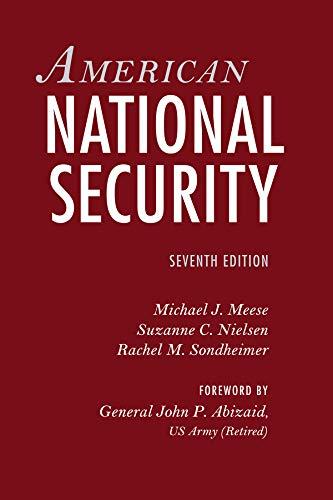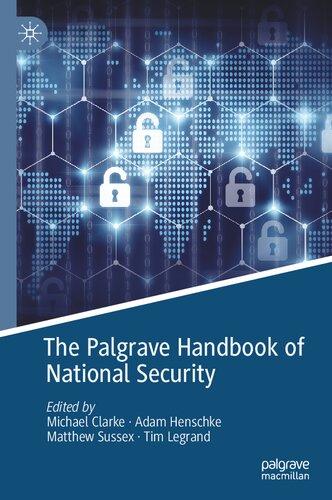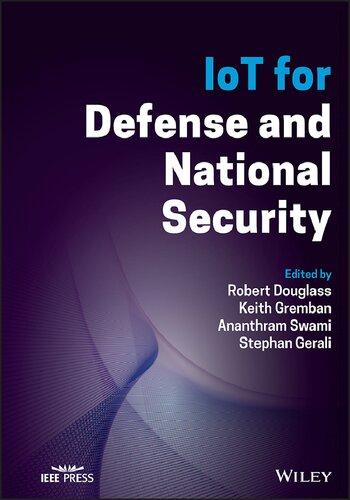
https://ebookmass.com/product/american-national-security-

Instant digital products (PDF, ePub, MOBI) ready for you
Download now and discover formats that fit your needs...
Psychiatric Mental Health Nursing Seventh, North American Edition – Ebook PDF Version, Revised – Ebook PDF Version
https://ebookmass.com/product/psychiatric-mental-health-nursingseventh-north-american-edition-ebook-pdf-version-revised-ebook-pdfversion/
ebookmass.com
The Palgrave Handbook Of National Security 1st Edition
Michael Clarke
https://ebookmass.com/product/the-palgrave-handbook-of-nationalsecurity-1st-edition-michael-clarke/
ebookmass.com
IoT for Defense and National Security Robert Douglass


https://ebookmass.com/product/iot-for-defense-and-national-securityrobert-douglass/
ebookmass.com
Digital Transformation Success: Achieving Alignment and Delivering Results with the Process Inventory Framework
Michael Schank
https://ebookmass.com/product/digital-transformation-successachieving-alignment-and-delivering-results-with-the-process-inventoryframework-michael-schank/
ebookmass.com



States will face an extremely complex security environment for the foreseeable future.
It is important to understand the perspectives and approaches that provide the context for American national security policy making. As discussed in part I of this book, “National Security Policy: What Is It, and How Have Americans Approached It?,” one of the strengths that the United States brings to policy making is its values. Those values are represented both by the ideals enshrined in the Constitution and Declaration of Independence and by the strength and dedication of the American people to do the hard work necessary to make the United States and the world a stronger, safer, and better place for future generations. A successful and sustainable approach to national security will rest on these values, which should continue to influence policy choices in the future.
With national security policy, it is sometimes difficult to understand all the players involved, which is addressed in part II, “National Security Policy: Actors and Processes.” During my career as a military leader, I worked with all the actors discussed, often engaging with the White House and Congress. With the intelligence, diplomatic, and homeland security communities as partners with the military, the challenge was to integrate our efforts in support of shared strategies. Understanding the proper role of the military, the vital importance of the budget process, and the intricacies of national security decision making are crucial to the effective formulation of security policy. There is no substitute for learning about all of these actors and agencies firsthand, but studying their history, culture, organization, and practices is a great first step toward understanding their important roles in American national security.
Recently, the United States seems to have had an overreliance on the military element of power. As this book describes in part III, “Ways and Means of National Strategy,” it is critical to understand and incorporate all elements of power when developing a successful long-term strategy. Our overreliance on the hammer of military power has created a dynamic that makes every problem look like a nail. While military action can gain time for political activity to take place, it is vital that we incorporate economic, diplomatic, informational, educational, intelligence, law enforcement, and other aspects of power in the development of a sustainable strategy. All elements of national power need to be adequately resourced so that we can
and unparalleled knowledge and experience of the two men to whom we dedicate this book: Amos A. Jordan and William J. Taylor Jr. Brigadier General Joe Jordan graduated as the highest-ranking cadet in the West Point Class of 1946, studied at Oxford University as a Rhodes Scholar, earned his PhD from Columbia University, and served on the faculty in the Department of Social Sciences at West Point for twenty years, eventually retiring as the Professor and Head of the Department. He continued to serve in senior civilian positions in the Department of Defense and the Department of State and was a member of the President’s Intelligence Oversight Board. He served as President and Chief Executive Officer of the Center for Strategic and International Studies (CSIS), President of the CSIS Pacific Forum, and as a Senior Advisor at the Wheatley Institution at Brigham Young University. Colonel Bill Taylor was commissioned through the US Army Officer Candidate School (OCS) in 1955 and was later elected to the OCS Hall of Fame. He earned his PhD from American University and served on the faculty in the Department of Social Sciences at West Point for sixteen years. At the time of his retirement, he was serving as the Director of National Security Studies. He then became an Adjunct Professor at Georgetown University’s School of Foreign Service and served at CSIS, where he led the International Security Program, was a Senior Advisor, and helped lead the professional development program. These men provided a tremendous legacy of excellence, precision, rigor, and clarity one that continues to inform this seventh edition of American National Security.
As faculty in the Department of Social Sciences in the 1970s, Jordan and Taylor recognized the need for a textbook that would explain US national security to an audience with renewed interest in security issues after the Vietnam War. The first edition was published in 1981 and quickly became the most relied-upon text in national security policy courses at institutions serving undergraduates, graduate students, and military and civilian government professionals. Subsequent editions of the book followed the same basic approach identifying the history, continuities, and trends in American national security policy that provide context for the contemporary challenges that policy makers face on a daily basis. Jordan and Taylor combined their efforts with Lawrence J. Korb of the Brookings Institution for the third and fourth editions, and Michael J. Mazaar of CSIS for the fifth edition. The sixth edition returned partial responsibility for the book’s
authorship to the Department of Social Sciences at West Point, as Jordan and Taylor recruited Michael Meese and Suzanne Nielsen, previous and current Department Heads, respectively, to co-author that edition. Rachel Sondheimer, an Associate Professor who teaches American politics at West Point, has joined Meese and Nielsen to co-author this seventh edition.
The Department of Social Sciences at West Point is responsible for teaching the disciplines of political science and economics to cadets, and it is also home to the Combating Terrorism Center, which provides cutting-edge research on the terrorist threat, as well as the Office of Economic and Manpower Analysis, which supports the Army’s senior leaders as they shape the future force. It is a national resource of talented military and civilian faculty who teach cadets about the national security policies that they will observe, encounter, help develop, and execute throughout their professional careers. Classrooms at West Point are the ideal laboratory to test the concepts from this text, and the current version has benefited greatly from the insights of faculty and students as it was developed. Indeed, this work would not have been possible without this collaboration at the United States Military Academy, which is among the reasons why proceeds from the sale of this book are donated back to West Point. Several faculty members leveraged their considerable national security expertise to help draft significant revisions to many chapters. In particular, we would like to acknowledge the work of Terry Babcock-Lumish (“Putting the Pieces Together: National Security Decision Making” and “Nuclear Policy”), Jordan Becker (“Europe”), Ruth Beitler (“The Middle East”), Ryan Bell (“Putting the Pieces Together: National Security Decision Making” and “Nuclear Policy”), Steven Bloom (“Economics”), Roxanne Bras (“Irregular Threats: Terrorism, Insurgencies, and Violent Extremist Organizations”), Tania Chacho (“East Asia”), Robert Chamberlain (“Latin America”), Meghan Cumpston (“The International Setting”), Joe DaSilva (“The Evolution of American National Security Policy” and “Congress”); Brian Dodwell (“Homeland Security”), Dean Dudley (“Planning, Budgeting, and Management”), Brian Forester (“Presidential Leadership and the Executive Branch” and “South Asia”), Jim Golby (“The Role of the Military in the Policy Process” and “Military Power”), Jessica Grassetti (“Planning, Budgeting, and Management”), Liesl Himmelberger (“East Asia”), Seth Johnston (“Europe”), Bonnie Kovatch (“Sub-Saharan Africa”), Patrick Kriz (“Latin America”), Charlie Lewis (“The
CCP Chinese Communist Party
CENTCOM US Central Command
CENTO Central Treaty Organization
CFE Conventional Forces in Europe (treaty of 1990)
CFIUS Committee on Foreign Investment in the United States
CIA Central Intelligence Agency
CJTF-HOA Combined Joint Task Force-Horn of Africa
COIN counterinsurgency
COM chief of mission
COMINT communications intelligence
CPA Coalition Provisional Authority
CSCC Center for Strategic Counterterrorism Communications
CSCE Conference for Security Cooperation in Europe
CSSTA Cross-Strait Services Trade Agreement
CTR Cooperative Threat Reduction
CVE countering violent extremism
CYBERCOM US Cyber Command
DC Deputies Committee (of the National Security Council)
DCA Defense Cooperation Agreement
DCI Director of Central Intelligence
DCS defense commercial sales
DEA Drug Enforcement Agency
DHS Department of Homeland Security
DIA Defense Intelligence Agency
DISA Defense Information Systems Agency
DMZ demilitarized zone (Korean peninsula)
DNI Director of National Intelligence
DoD Department of Defense
DoDIN Department of Defense Information Network
DOJ Department of Justice
DPP Democratic Progressive Party (Taiwan)
DPRK Democratic People’s Republic of Korea (North Korea)
DSCA Defense Security Cooperation Agency
DTRA Defense Threat Reduction Agency
ECOWAS Economic Community of West African States
ELINT electronic intelligence
ESDP European Security and Defense Program
EU European Union
F3EAD find, fix, finish, exploit, analyze, and disseminate
FATA Federally Administered Tribal Areas
FBI Federal Bureau of Investigation
FDI foreign direct investment
FDR Franklin Delano Roosevelt
FEMA Federal Emergency Management Agency
FIRE Firefighter Investment and Response Enhancement
FISA Foreign Intelligence Surveillance Act
FISINT foreign instrumentation signals intelligence
FMF foreign military financing
FMS foreign military sales
FSB Federal Security Service (Russian)
FTAA Free Trade Area of the Americas
FY fiscal year
G7, G8, or
G20 group of seven, eight, or twenty (international economic forums)
GAO Government Accountability Office
GATT General Agreement on Tariffs and Trade
GDP gross domestic product
GEOINT geospatial intelligence
GNP gross national product
GPS global positioning system
HASC House Armed Services Committee
HPSCI House Permanent Select Committee on Intelligence
HSC Homeland Security Council
HUMINT human intelligence
IADB Inter-American Development Bank
IAEA International Atomic Energy Agency
IBRD International Bank for Reconstruction and Development
ICBM intercontinental ballistic missile
IED improvised explosive device
IGO intergovernmental organization
IMF International Monetary Fund
IMINT imagery intelligence
INF Intermediate-Range Nuclear Forces (treaty of 1987)
IOB Intelligence Oversight Board
IRBM intermediate-range ballistic missile
ISAF International Security Assistance Force
ISIL Islamic State in Iraq and the Levant
ISR intelligence, surveillance, and reconnaissance
JCS Joint Chiefs of Staff
JSTARS Joint Surveillance Target Attack Radar System
JTTF joint terrorism task force
KGB Committee for State Security (Russian)
START Strategic Arms Reduction Treaty (1991)
TCO trans-national criminal organization
TPP Trans-Pacific Partnership
TSCTP Trans-Saharan Counterterrorism Partnership
TTIP Transatlantic Trade and Investment Partnership
UAV unmanned aerial vehicle
UN United Nations
USA
PATRIOT Uniting and Strengthening America by Providing Appropriate Tools Required to Intercept and Obstruct Terrorism
USAID United States Agency for International Development
USIA US Information Agency
VEO violent extremist organization
VTC video teleconference
WMD weapons of mass destruction
WTO World Trade Organization
YPG Kurdish People’s Protection Units
to states. Advocates for a focus on this broader security agenda an agenda that has received greater emphasis since the end of the Cold War believe that these issues deserve a place next to the traditional focus on the security competition among states as national security priorities.3
A second question, which is related but even more fundamental, is raised by scholars and policy advocates working in a field known as human security. These advocates question the adequacy of the concept of national security itself by disputing the presumption that the state rather than the individual is the key unit of concern. Particularly in predatory, failing, or failed states, security from external threats may not be the most urgent consideration. Human security is also related to transnational security challenges. According to the United Nations (UN), “Human security is needed in response to the complexity and the interrelatedness of both old and new security threats from chronic and persistent poverty to ethnic violence, human trafficking, climate change, health pandemics, international terrorism, and sudden economic and financial downturns. Such threats tend to acquire transnational dimensions and move beyond traditional notions of security that focus on external military aggressions alone.”4 Threats to human security vary across time and are highly context-specific. Human security scholars vary in the definitions that they use; some focus on the full range of threats to personal well-being and dignity, while others focus more narrowly on political violence. However, they agree on putting the welfare of individuals at the center of their analyses.5
The term national security is an elastic one; its meaning and implications have expanded, contracted, and shifted over time. Reminiscent of Dr. Samuel Johnson’s definition of patriotism as “the last refuge of scoundrels,” protection of national security has sometimes even been invoked to justify or conceal illegal acts. Because national security issues can involve high stakes, it is especially important to analyze critically any argument that employs national security as a justification for a position or action. It is also useful to remember that national security policy in the US context serves both material interests and nonmaterial values and to return occasionally to first principles. Does a particular policy further US security or economic interests or values while preserving the US Constitution and the framework it establishes for the American way of life? If the answer to that question is uncertain, then so may be the grounds on which a particular policy rests.
